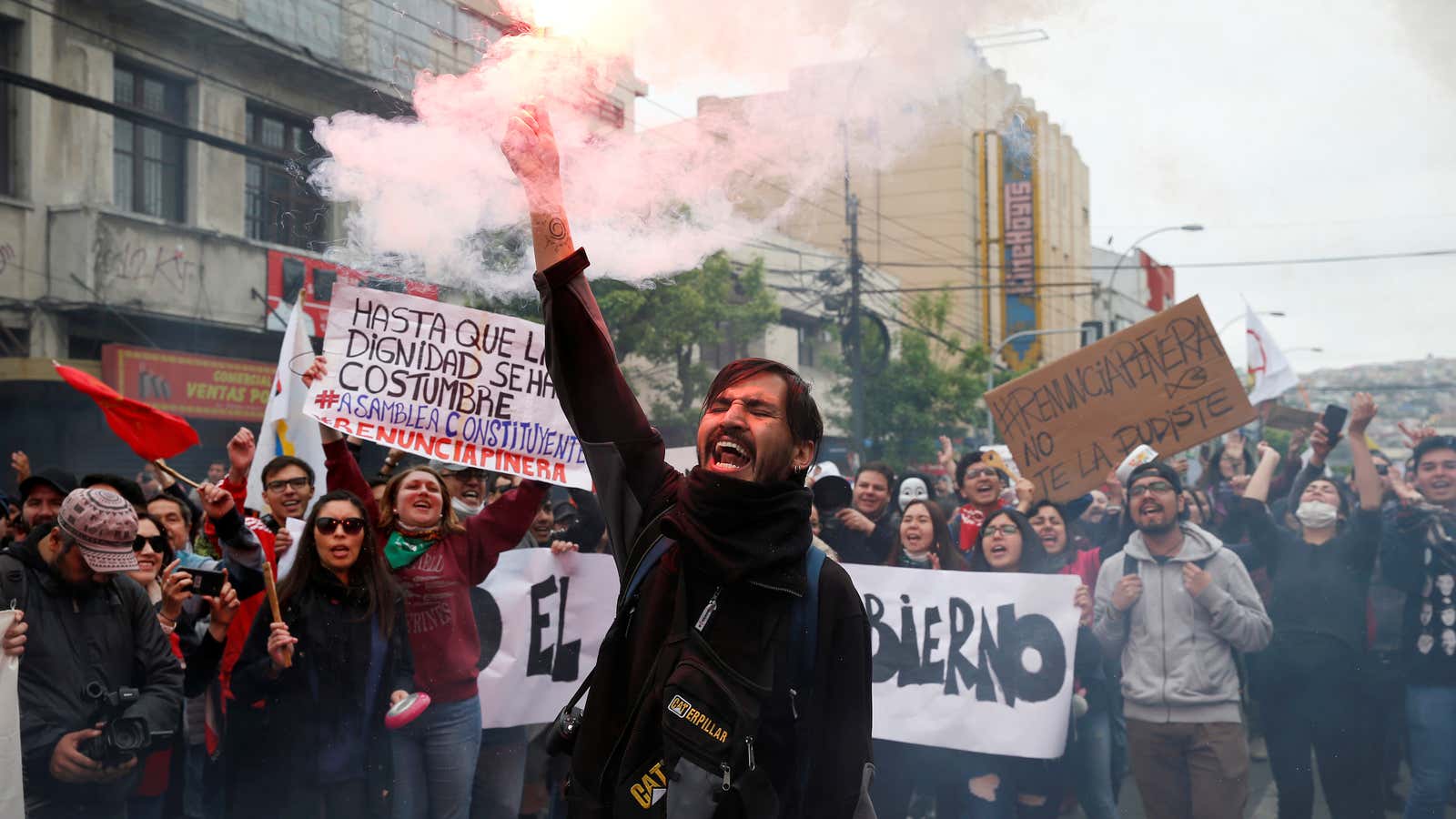It all started with a protest over rising subway fares. Now Chile is in the grip of violent demonstrations about the entire economic system. The grievances include the rising cost of higher education, healthcare, transportation, as well as the small pensions of retirees. Other Latin American countries’ populations are protesting, too, but Chile is surprising because it is Latin America’s economic success story. It has a sizable middle class, and has emerged as a middle-income country. It’s even a member of the club for rich countries, the Organization for Economic Cooperation and Development. But the unrest suggests the goal of mainstream economists for the last several decades—steady growth—may not be enough if insecurity and inequality still persist.https://data.worldbank.org/?locations=ZJ-CL
Chile’s government embraced economic orthodoxy, privatized industries and pensions, was fiscally responsible, and used sensible monetary policy. Throw in a well-managed boom in the price of copper in part driven by Chinese demand and Chile’s economy became the break-out star of Latin America. Its income per capita is nearly twice the average among countries in the region.
It also has one of the highest life expectancies, 79.5 years–compared to 75 years the Latin American average.
If you asked economists 10 or 20 years ago, they’d call Chile’s growth an unambiguous success and wouldn’t have predicted this much discontent. After all, Chile’s booming economy delivered many material benefits to its citizens—so what do they have to complain about? The New York Times argues the unrest erupted because those gains were not equally shared. And inequality is one of the issues raised by the protesters. But inequality, as measured by income, has fallen in Chile since the 1980s. Extreme inequality is common in poor countries that tend to include many poor people and a few very rich ones. Chile’s economic growth not only created a robust middle class, it also improved the lives of the poorest. According to the World Bank, Chileans are less likely to live in slums, have a lower homicide rates, and are twice as likely to live on more than $3.50 a day compared to their Latin American neighbors. Most Chileans did benefit from economic growth, even if those gains were not equally shared.
Tyler Cowen, an economist at George Mason and frequent blogger, says the problem is more complex than class resentment. He argues protests are largely about the middle class wanting necessary consumer goods. Many of the protestors are university students, not the poorest Chileans. In many ways the protests in Chile are more like last year’s yellow-vest protests in France than the unrest in Venezuela and Ecuador. Both France and Chile feature a middle class that feels neglected, even if their living standards have improved, and that their income can not keep up with the rising cost of living. Cowen points out that price increases tend to spark protests, and he expect more price controls in many countries (and the shortages that go along with them) in the future.
The problem is not that there is a division between the richest and the poorest but because the middle class feels it can’t afford goods and services, like health and education, that are necessary for prosperity and an ability to compete. They also face more uncertainty about their economic future and are worried about their retirement. The social safety net may work better for the poor, but is inadequate to keep the middle class afloat.
This all shows that economic growth is not always enough. For the last several decades, economists pursued policies where reducing poverty and promoting growth were the main objectives. Now some are wondering if policies should also aim to reduce inequality in order to maintain social order. It’s a radical departure from the well-defined, easy-to-measure objectives economists are used to. Though even if economists could define an optimal amount of inequality it’s not clear this would make society more stable. The sources of social unrest are still not fully understood and making rich people less rich doesn’t necessarily address the sources of middle-class economic anxiety.
Maintaining a prosperous middle class also requires it feels financially secure and that their standards of living continues to rise. Chile’s economy may look successful compared to other Latin American countries, but by rich country standards—as defined by the OECD— it still has higher rates of income inequality, has less generous pensions and the government spends less on its citizens as a share of GDP. Chile has become so successful it may be time to compare it to other rich countries—like its citizens do.
